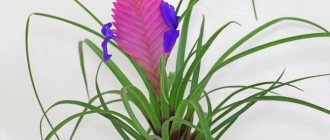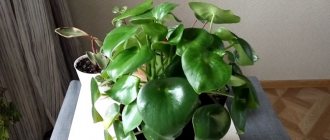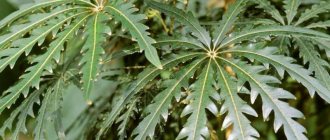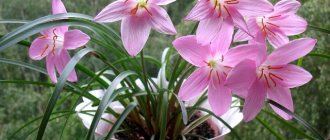What it looks like, what family it belongs to
Peperomia watermelon belongs to the Pepper family. This is a perennial evergreen crop. Flowers come in a variety of varieties, so everyone can choose the perfect variety for themselves.
Peperomia foliage looks like a watermelon
A common feature of all varieties is leathery, shiny foliage, but it also differs in color and shape. Some species have small and thin leaves, while others have fleshy and wide plates with curled ends.
Interesting to know! If you lightly rub a peperomia leaf, it will begin to emit an aroma reminiscent of bell pepper.
The variety of watermelon peperomia can be easily identified by its botanical description. No other crop has such remarkable leaves.
Common varieties
Peperomia - types tin, wrinkled, clusifolia, watermelon, variegated
Peperomia is represented by a variety of varieties. The most prominent representatives:
Variegated
The variety is distinguished by beautiful leaves with fancy variegated colors and an unusual shape.
Variegate peperomia
Climbing
The culture grows up to 1.5 meters in height. With age, the leaves of the bush change color from beige to cream. Indoor flowers are undemanding in care and maintenance.
Variety of climbing peperomia
wrinkled
A decorative crop that stands out from the rest with its miniature appearance. Mature bushes do not grow more than 10 cm. It blooms with white buds that emit a unique aroma.
Representative of the wrinkled species
Lillian
A low-growing variety that has an external resemblance to lilies. After flowering, berries form on the plant.
Miniature Lilian is popular among gardeners
Silver
Popular view. It is valued for its beautiful light leaves with dark veins. In general, the plant has more than 30 varieties. Each of them differs in shape, size and cultivation characteristics.
Silvery peperomia is famous for its unusual leaf color.
Briefly about the history of appearance
Peperomia magnoliafolia - home care
The homeland of watermelon peperomia is considered to be South and Central America, as well as India. It was there that this unusual flower was first discovered. Most often found in tropical forests, it prefers to grow in shady undergrowth and also on tree trunks. The plant is literally attached to the bark.
Peperomia has the ability to accumulate moisture in its own leaves, which is why it can go without water for a long time.
Description of appearance, geography of habitat
Peperomia watermelon is considered the most attractive of its kind. Its distinctive feature is striped leaves.
This low plant can reach 12 cm in height.
The flower has smooth, leathery and fleshy leaves. On average, they grow up to 5-8 cm. Depending on the species, the leaves can be located quite tightly to each other and form a rosette. The stems are thin and have a reddish tint. The root system is tuberous or in the form of a long creeping rhizome. The flowering period begins in summer. The flowers do not have any special decorative value or emit a scent.
In nature, watermelon peperomia grows on peat soils. Its homeland is South America, where it grows as a ground cover plant. This species is also found in Southeast Asia and India.
Features of care
Watermelon peperomia is an unpretentious crop. She does not require special attention. It is for these qualities that flower growers love her.
Temperature
For normal growth and development, the plant needs the right climatic conditions. A certain temperature regime must be maintained in the room, namely:
- in summer – 20-22 ℃;
- in winter – 18-20 ℃.
It is important to monitor the temperature of the substrate. It should not be below +17 ℃. In colder soil, it is difficult for the peperomia root system to remain viable.
Lighting
The culture prefers eastern and western window sills. If the pot is on the south side, then the flower needs darkening.
In winter, on the contrary, the plant lacks light, so it will have to be artificially illuminated.
Note! Daylight should not last less than 8 hours. For this, fluorescent lamps are used.
Watering
Irrigation water should be at room temperature. Abundant watering is carried out during the growing season and flowering; the rest of the time, water is added as usual. The main thing is not to let the soil dry out, this has a bad effect on watermelon peperomia.
Spraying
If the air in the room where the flower pot is located is too dry, spraying is mandatory. Otherwise, the peperomia will begin to dry out. This should be done at least once every three days.
Humidity
Tropical crops require high humidity. If this indicator is low in the house, then you will have to spray the bushes daily. A container of water placed next to the pot will help correct the situation.
Priming
The substrate for peperomia should be loose and rich in nutrients. You can make it yourself from the following components:
- humus;
- garden soil;
- sand;
- peat soil.
All components are taken in equal volume. When choosing a flowerpot, preference is given to deep containers so that the root system feels free.
Feeding
As for fertilizers, they are applied throughout the season, starting in April and continuing until autumn. Two feedings are carried out per month. Ready-made mineral complexes are suitable for this.
In winter, the flower is not fertilized, since it is in a dormant state; nutrients can cause its activity. The plant will not be able to fully recover.
The soil
These peperomias do well in most standard potting mixes as long as they drain well, but can also hold some moisture. Avoid soil designed for plants that prefer drier soil, such as cacti and succulents, as it will not absorb enough water to support the plants. A 1:1 mixture of peat moss and perlite is also suitable for watermelon peperomia.
When and how does it bloom
Each peperomia variety blooms differently. It is sometimes extremely difficult to achieve flowering. Some gardeners wait for years for the inflorescences to appear. In good conditions, inflorescences appear in late spring or early summer.
Peperomia throws out flower stalks in the form of cobs
Types of flowers
During the flowering period, numerous buds appear on the shoot, reaching up to 7 cm in length. They look like a thin bent process.
Additional Information! In the end, in some varieties, fruits are formed in place of the inflorescences, which can be easily separated from the cob.
Flower shapes
The shape of the buds directly depends on the variety. The wrinkled one throws out tendrils, on which white cobs later form. The view pleases with buds throughout the year.
The whorled plant has a long peduncle. Chisel-shaped peperomia are covered with small white-green flowers in summer.
Flowering period
The ovary of inflorescences in indoor plants begins in the spring and lasts all summer. Some representatives are able to bloom throughout the year without going dormant. After this, the plant rests for several years.
How does watermelon peperomia reproduce?
Peperomia is propagated in several ways. The choice of method directly depends on the capabilities and experience of the grower. It is worth considering each option in detail.
Germination from seeds
Seed propagation begins in early May. Before planting, the seeds are soaked. After an hour, they are laid out on the surface of a moist nutrient substrate and sprinkled with soil.
The container with planting material must be covered with plastic film. This will provide a greenhouse effect. After 50-60 days, the first shoots will appear.
Note! Peperomia can be planted in separate flowerpots only when the third leaf appears on the shoot.
Rooting cuttings
The procedure is carried out in the spring. To do this, do the following:
- cut off the shoot with a sharp knife; it should contain 2-3 independent buds;
- planted in nutrient soil, covered with a plastic bottle;
- place the container with the cuttings in a warm place;
- After the roots have formed, they are planted in a separate pot.
Usually the whole process takes about a month. During this period of time, the root system has time to develop normally. Then the flower is given standard care.
Propagation by cuttings is carried out in the spring
Other options
Some gardeners use the leaves for propagation. They are simply stuck edgewise into the substrate and covered with a plastic cup on top.
Another option is dividing the bush. To do this, the plants are taken out of the pot, divided into several parts, and then planted in separate containers.
Reproduction
Plant division is quite simple, and several types of propagation are available.
Propagation of peperomia by cuttings
This is the most accessible and popular type of flower division. The cut cuttings are cleared of all leaves except the top ones, left to dry for 1-1.5 hours and planted for rooting in a sand-peat mixture for 1-1.5 months.
The soil temperature should be at least 25C. Many species can be rooted in water. To do this, place the cuttings in warm water and wait for roots to form.
Peperomia propagation by leaf
A leaf separated from the cutting with a petiole of at least 1 cm is treated with root and immersed in a sand-peat mixture.
The container is covered with a bag on top and left at a temperature of 19-21 degrees under diffused lighting. For 1-1.5 months, the soil is moderately moistened, and the pot is turned towards the light so that new rosettes at the base of the leaf form evenly. Then the new root shoots are divided and planted. Their flowering is possible already in the first year.
Some plant varieties, such as silver peperomia, can reproduce from parts of the leaves. The main condition is the presence of a minimum part with which the leaf is attached to the stem.
Transfer
The first peperomia transplant is carried out at the 3rd year. Young bushes do not need this procedure. An adult plant is transplanted into a new flowerpot once every two years. It is best to do this in April.
The event is carried out as follows:
- a drainage layer is placed in the flowerpot so that liquid does not accumulate in the soil;
- the nutrient substrate is added to 2/3 of the total volume of the pot;
- a plant is placed in the center and covered with earth;
- the soil is compacted and moistened.
Important! You should not feed newly transplanted peperomia. The new soil contains nutrients that are sufficient for normal development. Excess fertilizer can be harmful.
Beneficial features
Peperomia silver.
Photo Needs regular care. In return, it improves the atmosphere in the house, cleanses the air of toxins and formaldehyde vapors, gives a good mood and well-being, creates a favorable aura, and saturates the room with oxygen. The house plant has a beneficial effect on the organs of the digestive system.
Possible problems in growing watermelon peperomia
Flowers don't get sick as often if you care for them properly. It is important to provide them with conditions that are as similar as possible to their natural environment.
Pests
Like any other vegetation, peperomia is susceptible to attack by harmful insects. Most often the following appear on flowers:
- thrips;
- mealybugs;
- Scale insects.
You can get rid of them with the help of insecticidal preparations.
To avoid problems in the future, you need to carry out prevention. Inspect watermelon peperomia bushes for pests. Most often they hide on the back of the leaf. If the damage is minor, you can treat the plant with a soap solution.
Other problems
Flower growers often encounter problems when growing indoor flowers due to improper care. The plant begins to hurt due to hypothermia or waterlogging of the substrate.
There are several external signs that indoor culture needs something:
- falling leaves indicates a lack of moisture; it is necessary to increase the amount of moisture;
- a brown edging on the foliage indicates a low temperature in the room, the flower is freezing;
- putrefactive lesions are a clear sign of excess water in the soil;
- wrinkled leaves are a signal that there is not enough light in the room; it is worth moving the pot to a brighter place or installing additional lighting.
Watermelon peperomia will decorate your interior with proper care
If at least one of the signs is observed, you should take immediate action: check the humidity in the room, eliminate drafts. Care should be taken when caring for watermelon peperomia at home.
Humidity
Air humidity is not important for the plant. It thrives both in tropical rainforests and in arid city apartments. It is not worth spraying peperomia - water rolls off its smooth glossy leathery leaves and is not absorbed at all. This is a natural protection of leaves from waterlogging. Still, the plant sometimes needs to be wiped with a damp sponge or bathed in the shower to remove dust.











